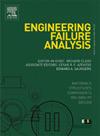冷成形WC-Co镶块渗硼对磨损和疲劳寿命的影响
IF 4.4
2区 工程技术
Q1 ENGINEERING, MECHANICAL
引用次数: 0
摘要
冷锻是紧固件生产中的关键制造工艺,利用多阶段模具系统在高压应力下使材料塑性变形。在挤压、还原和封头成形等冷成型操作中,模具应用中广泛采用WC-Co材料,并根据工艺的具体要求进行选择。这些用于冷成型的模具材料必须表现出高的耐磨性和疲劳强度,因为在模具内产生巨大的成形力。渗硼是一种表面处理方法,用于提高这些机械性能。本文研究了包渗硼处理对冷锻模系统中含钴量为19%的WC-Co材料疲劳寿命和磨损性能的影响。采用ekabor2型硼粉在1000℃、950℃、900℃三个温度条件下包硼3组样品,共包硼4 h。在包渗后,进行了无润滑和润滑条件下的销对板磨损试验,以评估样品的磨损性能。采用三点弯曲疲劳试验对渗硼试样的疲劳性能进行了评价。疲劳试验结束后,根据试验结果得到Goodman-Haigh图,用于模具寿命预测计算。x射线衍射(XRD)分析证实在渗硼层中形成了CoB、Co2B、WB2和W2CoB2相。结果表明,提高渗硼温度可显著提高合金的耐磨性和表面硬度,在1000℃时,合金的显微硬度最高(4104 HV0.1),磨损轨迹宽度最低(无润滑时为183µm,润滑时为70.76µm)。然而,厚而脆的硼化物层引起应力集中,对材料的疲劳性能产生不利影响。根据Goodman-Haigh图,在950°C条件下,渗硼后的最高疲劳寿命为5,000,000次,而在1000°C条件下,渗硼后的最低疲劳寿命为135,356次,温度为450 MPa。虽然WB2相在1000℃时硬度的提高提高了耐磨性,但脆性硼化物层的形成导致应力集中,促进裂纹的形成,降低了模具寿命。这表明,虽然较高的渗硼温度提高了表面硬度,但也增加了脆性,对材料的疲劳性能产生了负面影响。本文章由计算机程序翻译,如有差异,请以英文原文为准。
Effect of boriding on wear and fatigue life of WC-Co die inserts in cold forming
Cold forging is a key manufacturing process in fastener production, utilizing multi-stage die systems to plastically deform materials under high compressive stresses. In cold forming operations such as extrusion, reduction, and head forming, WC-Co materials are widely employed in die applications, selected based on the specific requirements of the process. These die materials used in cold forming must exhibit high wear resistance and fatigue strength due to the substantial forming forces that generate significant stresses within the dies. Boriding, a surface treatment method, is applied to enhance these mechanical properties. This study investigates the effects of pack-boriding treatment on the fatigue life and wear properties of WC-Co material containing 19 % Co, which are used as die inserts in cold forging die systems. Three sets of samples were pack-borided using EKABOR-2 boron powder at 1000 °C, 950 °C, and 900 °C for 4 h under each temperature condition to accomplish this process. Following the pack-boriding process, pin-on-plate wear tests were conducted under both non-lubricated and lubricated conditions to evaluate the wear performance of the samples. Three-point bending fatigue tests were performed to assess the fatigue behavior of the borided samples. After the fatigue test, Goodman-Haigh diagrams were obtained from the experimental results to be utilized in predictive die-life calculations. X-ray diffraction (XRD) analysis confirmed the formation of CoB, Co2B, WB2 and W2CoB2 phases in the borided layer. Results indicate that increasing boriding temperature significantly improves wear resistance and surface hardness, with the highest microhardness (4104 HV0.1) and the lowest wear track width (183 µm non-lubricated, 70.76 µm lubricated) measured at 1000 °C. However, the thick and brittle boride layer induced stress concentrations, negatively affecting the material’s fatigue performance. According to the Goodman-Haigh diagrams, the highest fatigue life after boriding was measured as 5,000,000 cycles at 950 °C, while the lowest was 135,356 cycles at 450 MPa after boriding at 1000 °C. Although the increased hardness of the WB2 phase at 1000 °C enhanced wear resistance, the formation of a brittle boride layer led to stress concentrations, facilitating crack initiation and reducing die life. This indicates that while higher boriding temperatures improve surface hardness, they also increase brittleness, negatively impacting the material’s fatigue performance.
求助全文
通过发布文献求助,成功后即可免费获取论文全文。
去求助
来源期刊

Engineering Failure Analysis
工程技术-材料科学:表征与测试
CiteScore
7.70
自引率
20.00%
发文量
956
审稿时长
47 days
期刊介绍:
Engineering Failure Analysis publishes research papers describing the analysis of engineering failures and related studies.
Papers relating to the structure, properties and behaviour of engineering materials are encouraged, particularly those which also involve the detailed application of materials parameters to problems in engineering structures, components and design. In addition to the area of materials engineering, the interacting fields of mechanical, manufacturing, aeronautical, civil, chemical, corrosion and design engineering are considered relevant. Activity should be directed at analysing engineering failures and carrying out research to help reduce the incidences of failures and to extend the operating horizons of engineering materials.
Emphasis is placed on the mechanical properties of materials and their behaviour when influenced by structure, process and environment. Metallic, polymeric, ceramic and natural materials are all included and the application of these materials to real engineering situations should be emphasised. The use of a case-study based approach is also encouraged.
Engineering Failure Analysis provides essential reference material and critical feedback into the design process thereby contributing to the prevention of engineering failures in the future. All submissions will be subject to peer review from leading experts in the field.
 求助内容:
求助内容: 应助结果提醒方式:
应助结果提醒方式:


